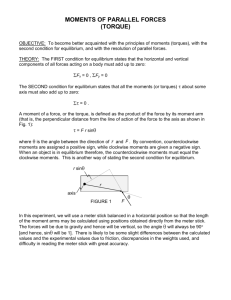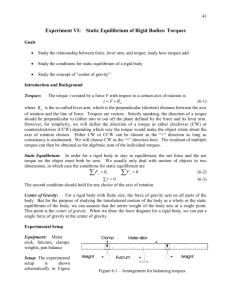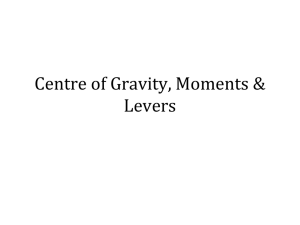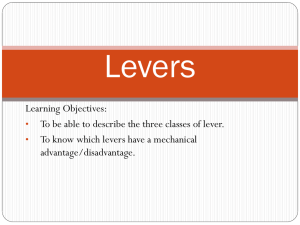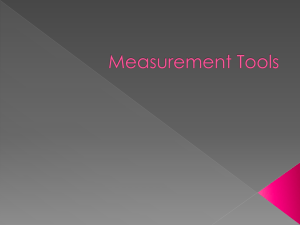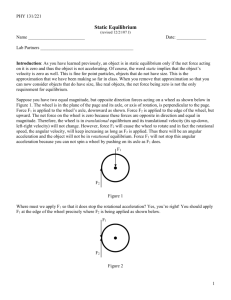Moments of Parallel Forces (Torque)
advertisement
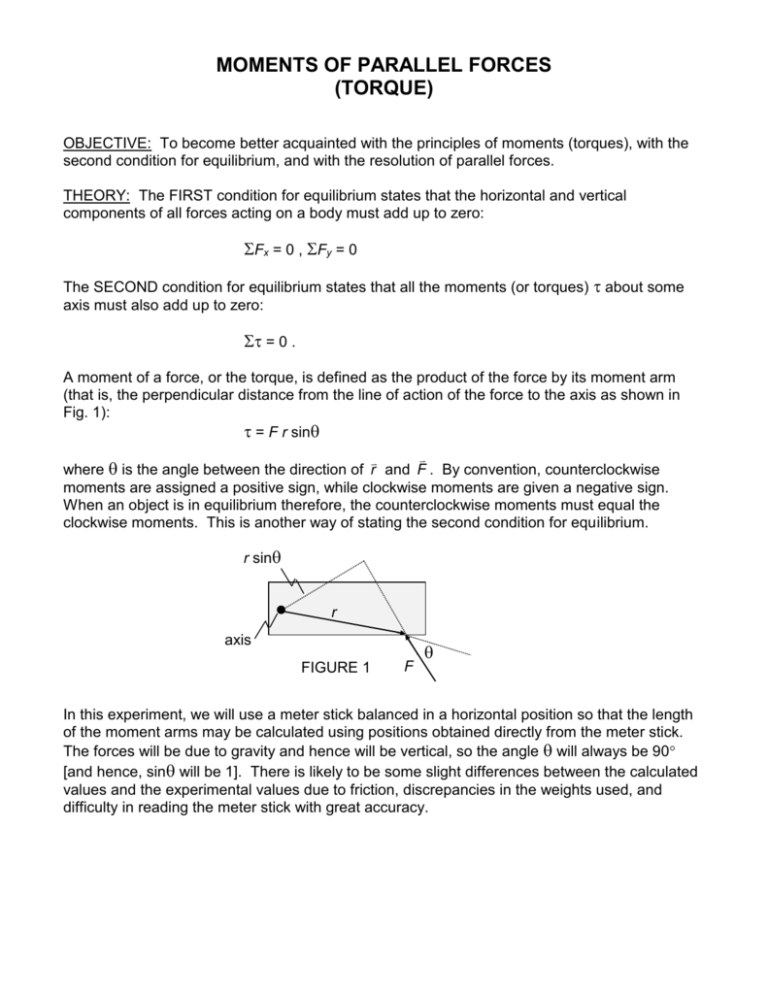
MOMENTS OF PARALLEL FORCES (TORQUE) OBJECTIVE: To become better acquainted with the principles of moments (torques), with the second condition for equilibrium, and with the resolution of parallel forces. THEORY: The FIRST condition for equilibrium states that the horizontal and vertical components of all forces acting on a body must add up to zero: Fx = 0 , Fy = 0 The SECOND condition for equilibrium states that all the moments (or torques) about some axis must also add up to zero: = 0 . A moment of a force, or the torque, is defined as the product of the force by its moment arm (that is, the perpendicular distance from the line of action of the force to the axis as shown in Fig. 1): = F r sin where is the angle between the direction of r and F . By convention, counterclockwise moments are assigned a positive sign, while clockwise moments are given a negative sign. When an object is in equilibrium therefore, the counterclockwise moments must equal the clockwise moments. This is another way of stating the second condition for equilibrium. r sin r axis FIGURE 1 F In this experiment, we will use a meter stick balanced in a horizontal position so that the length of the moment arms may be calculated using positions obtained directly from the meter stick. The forces will be due to gravity and hence will be vertical, so the angle will always be 90 [and hence, sin will be 1]. There is likely to be some slight differences between the calculated values and the experimental values due to friction, discrepancies in the weights used, and difficulty in reading the meter stick with great accuracy. Moments of Parallel Forces (Torque) 2 Part 1: Weight and the Center of Gravity PROCEDURE: The mass and center of gravity of the meter stick itself must first be determined before we can proceed with more complicated cases. a) The center of gravity is found by balancing the meter stick on the vertical support by adjusting the plain knife edge (the fulcrum). The center of gravity will not be exactly in the center of the meter stick since one end has been weighted. Find and record the position of the center of gravity of this particular weighted meter stick. *NOTE: In all the following procedures, whenever a mass is hung from the meter stick, the mass of the knife-edged hanger must be added to that of the hanging mass and this total used in the calculations. Weigh each of the hangers using the digital scale and record their respective masses. Be sure to know the correct mass of a hanger when you use it. b) To determine the mass of the stick, place the fulcrum at 55 cm [or at 45 cm if your center of gravity was > 50 cm], and then adjust the hanger loaded with 100 gm until balance is achieved. QUESTION: Where is the weight of the meter stick considered to be located? In this case it is easiest to measure the moment arms from the fulcrum. QUESTION: Why? (HINT: the fulcrum provides a force, but what about the torque due to the force at the fulcrum?) From this information calculate the mass of the meter stick. c) Now move the fulcrum to 60 cm and then to 65 cm, EACH TIME calculating the mass of the meter stick. d) Average your three values for the mass of the stick. QUESTION: How close are the three values to one another? QUESTION: Should they have been the same? Now measure the mass of the stick using the scale and compare with your average mass. [In the calculations for Part 3, use the average of your three calculations for the mass of the meter stick.] Part 2: Statics and Torque To further check the principle of moments, place the plain fulcrum at the center of gravity. (This will then ELIMINATE THE TORQUE DUE TO THE WEIGHT of the meter stick since the weight will be directed through the center of gravity and hence have a zero moment arm.) a) Hang 200 gm at 15 cm from the fulcrum. Balance this with 100 gm on the opposite side. Determine the moment arm of the 100 gm by calculation AND measurement, and compare. b) Hang 200 gm 20 cm to the left of the fulcrum and 100 gm 35 cm also to the left of the fulcrum. Balance this with 200 gm on the right side. Compare calculated AND experimental values of the right side moment arm. c) On the right, hang 200 gm 15 cm from the fulcrum. On the left, hang 500 gm 15 cm from the fulcrum and 100 gm 30 cm from the fulcrum. Achieve balance by hanging 200 gm somewhere on the right. Again compare calculated AND experimental values of the moment arm. d) Determine the mass of the lead piece by hanging it 25 cm from the fulcrum and balancing it with 100 gm on the other side. Here, take the measured moment arm as correct, and calculate the mass. Compare the mass with that read from a scale. Moments of Parallel Forces (Torque) 3 Part 3: Determining the Balance Point: Calculation and Experiment THEORY: Parallel forces can be balanced by a single force (E) in the antiparallel direction. The value of this FORCE is determined by the FIRST condition of equilibrium. There will be only y-components involved. The point of application of this equilibrant can then be determined by using the SECOND condition for equilibrium. It will be convenient to take moments about the zero end of the meter stick. Why? As an example, consider Fig. 2. FIGURE 2 E x1 F1 x2 F2 x x3 F3 Experimentally, weights are hung at various places, and then the fulcrum is moved to achieve balance. Note: this means that the weight of the meter stick acting at the center of gravity must be taken into account and treated as one of the forces. Applying the first condition of equilibrium, Fy = 0: E - F1 - F2 - F3 = 0 . (1) Applying the second condition of equilibrium, = 0: F1 x1 + F2 x2 + F3 x3 = E x . (2) Solving Eq.(1) for E and using this in Eq.(2), we can solve for x: x = (F1 x1 + F2 x2 + F3 x3) / (F1 + F2 + F3) (3) This then locates the position of the equilibrant, which in the experiment is supplied by the fulcrum. PROCEDURE: a) Hang 200 gm at the 20 cm mark, and 100 gm at the 80 cm mark, and obtain balance by moving the fulcrum. Using the above equations, determine x and compare with the result of your experiment. b) Hang 200 gm at the 10 cm mark, 100 gm at 25 cm, and 200 gm at 70 cm, and again obtain balance by moving the fulcrum. Again, determine the position of the equilibrant and compare to the result of your experiment. REPORT: For each experimental procedure you performed, answer any QUESTIONS, report your experimental findings, and compare them with your calculated predictions. Discuss the major sources of error that would account for your discrepancies.
